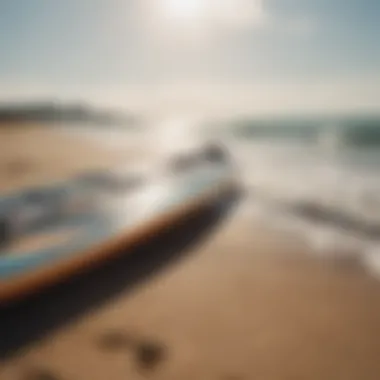Essential Gear for Your Kite Surfing Journey


Intro
Kite surfing, a blend of adrenaline and nature's beauty, draws countless enthusiasts to its thrilling embrace. For those ready to spread their wings in this exhilarating sport, having the right equipment is crucial—a well-thought-out kite surfing starter kit will set the foundation for many successful sessions on the water. Understanding what components are essential not only makes your entry smoother but also enhances safety and enjoyment.
You might wonder, what exactly should be in this starter kit? Well, beyond just a kite and board, there are various vital elements, including safety gear and a few accessories that can make your experience less daunting. Each piece of equipment plays a role, stemming from your local wind conditions to your personal preferences. In this guide, we will navigate through the various kites, boards, and supplementary items to ensure you’ll be navigating the waves with confidence.
Throughout this exploration, we will also touch upon selecting the gear that aligns well with your skill level. After all, starter kits are all about making informed choices to foster a safe but thrilling ride. Let's delve into the first aspect—gear insights, providing you a roadmap to get started on the right foot.
Gear Insights
Latest Gear Reviews
When looking at the current landscape of kite surfing gear, several brands stand out. Recent advances in design have brought some remarkable products to market.
- Ozone Zephyr: Recognized for its longevity and stable flight, it suits beginners and provides an enjoyable learning curve.
- North Reach: Known for its versatility, it adapts well to different conditions, making it a solid choice for newcomers.
- Cabrinha Switchblade: A fan favorite among intermediate users, this kite offers a mix of power and control that many aspire to master.
Each of these kites has been reviewed favorably across multiple platforms, showing that not all gear is created equal. Make sure to read reviews and check user experiences to see what resonates most with your intentions.
Essential Gear for Beginners
As a greenhorn in kite surfing, there are a few crucial pieces of gear that you shouldn't overlook:
- Kite: Your primary tool. It's the wing that lifts you off the tether, and having the right size matters based on your weight and local wind conditions.
- Board: Typically, a twin-tip board is recommended for beginners, as it offers ease of use and quicker progress.
- Harness: This connects you to the kite, allowing for better control. Comfort is key since you’ll be wearing it for extended periods.
- Safety Gear: A helmet should never be mentioned in passing—the ocean can be quite unforgiving, and protecting your noggin is every bit as important as your kite. A life vest or impact vest can also prove useful.
Don't forget about a good quality pump for your kite and possibly a repair kit for those "just in case" moments. It'll pay off to have these essentials ready when you're out on the water.
Remember, investing in quality gear from the start saves headaches down the road. You'll find that the balance between comfort and performance is critical.
In essence, as you gather your essential components, prioritize safety and reliability over flashy looks. It's about building confidence as you ride the surf, not getting caught up in the latest trend. Next, we shall discuss techniques and tips to ensure your riding experience remains both thrilling and safe.
Prelude to Kite Surfing
Kite surfing, an exhilarating blend of wind, water, and board, opens up a world of adventure for those seeking a thrilling connection with nature. This sport, which emerged in the 1980s, has evolved dramatically, becoming a favorite among thrill-seekers and beach bums alike. Understanding the essence of kite surfing is crucial for prospective enthusiasts ready to dive into this captivating domain. Such knowledge not only enriches the experience but also enhances safety and skill development.
The importance of light winds and the ability to harness their power is central to kite surfing. Riders use a large, steerable kite to propel themselves over water on a board, allowing them to perform tricks and ride waves. This interplay of elements—kite, board, and rider—creates a dynamic sport that requires practice, patience, and proper equipment.
Understanding the Basics of Kite Surfing
Before strapping on a kite and heading toward the sea, grasping some fundamental concepts is necessary. At its core, kite surfing relies on a kite's ability to utilize wind to generate lift and thrust. Riders steer the kite using a control bar connected by lines. The size and type of kite can significantly affect performance.
Each component plays a critical role. For instance, the kite size can directly influence your ability to maneuver in different wind conditions. Smaller kites are suited for higher winds, while larger kites catch more breeze and are ideal for lighter winds. Then there’s the board, providing stability and allowing for trick execution.
Participants must also understand various wind conditions and how those conditions will impact their riding experience. For beginners, light to moderate winds are the safest choice, while seasoned riders might prefer stronger gusts for more excitement. Knowing how to assess local conditions and select an appropriate spot for kite surfing can land you in a perfect setup for an enjoyable session.
Why Invest in a Starter Kit
Investing in a kite surfing starter kit is akin to preparing for a marathon—having the right tools is essential for success. A well-chosen starter kit typically features crucial components like a kite, board, harness, and safety equipment, all tailored for beginners. This approach simplifies the selection process, ensuring novices can focus on learning and enjoying the sport without getting lost in myriad choices.
A starter kit ensures that equipment matches skill level and provides a safety net for those learning the ropes. For instance, mastering the basics with a suitable kite size allows for improved control and confidence on the water. Additionally, getting quality gear is an investment in safety, as reliable equipment significantly reduces the risk of accidents.
Moreover, many training schools offer starter kits as part of their lessons, providing a practical path to acquisition while ensuring that learners have access to well-suited, functional gear. In the long run, investing in a starter kit can save money and prevent the frustration that comes from making ill-informed purchases.
Investing in a kite surfing starter kit not only equips you for success but also amplifies your enjoyment and safety on the water.
Essentials of a Kite Surfing Starter Kit
Types of Kites
Leisure Kites


Leisure kites are typically designed for beginners who want to enjoy the sport without jumping into all the complexities right away. These kites are generally more stable and easier to control, allowing newcomers to focus on mastering the fundamentals of kite flying. One standout feature of leisure kites is their ability to fly steadily in a range of wind conditions.
While leisure kites are great for learning, they might not provide the thrill that more advanced kites offer. Still, their user-friendly design encourages new kite surfers to build skills without feeling overwhelmed, making them a solid choice in the early stages of the kiteboarding journey.
Performance Kites
Performance kites cater to those who are ready to up their game. These kites are crafted for high speeds and impressive responsiveness. The key characteristic of performance kites is their ability to perform under pressure, allowing riders to tackle more challenging conditions with agility and precision.
These kites often feature advanced materials and design elements that enhance lift and control. However, their complexity means that they can be daunting for novices. It’s essential to have a solid foundation in kite control before transitioning to performance kites; otherwise, you might find yourself in over your head.
Foil Kites
Foil kites are distinct from traditional kites in that they use an internal structure to maintain shape, making them incredibly efficient in providing lift. This efficiency allows for excellent performance, especially when the wind is light. Foil kites are popular among experienced riders who appreciate their versatility and ease of maintenance.
However, their design can be a double-edged sword. While they excel in specific conditions, they can be less stable in gusty winds compared to other types. For beginners feeling adventurous, connecting with an instructor who can help navigate these intricacies is advisable.
Choosing the Right Board
Directional Boards
Directional boards are intended for riders who wish to ride in one direction, generally aligning with surfboard styles. They excel in wave riding and offer a different experience compared to more versatile boards. One significant advantage is the ride quality in surf conditions—these boards can carve smoothly on the face of waves, providing a thrilling experience.
For newcomers focusing on traditional kiteboarding without waves, directional boards might be less practical. They require a different skill set that may not align with a beginner’s early experiences. Thus, careful consideration is needed before making a choice.
Twin-Tip Boards
Twin-tip boards are designed for versatility, suitable for both beginners and advanced riders. The unique feature of a twin-tip board is its symmetrical shape, allowing riders to ride in either direction without flipping. This characteristic makes learning to kiteboard easier since you won't have to worry about your stance when you catch a gust.
Though ideal for those starting out, these boards can sometimes feel less stable under specific conditions compared to directional boards. However, their adaptability makes them a popular choice among newcomers eager to explore various styles of kiteboarding.
Foil Boards
Foil boards are a newer addition to the kiteboarding scene and offer a unique experience by lifting above the water's surface. The key feature is the hydrofoil that allows riders to glide smoothly along with minimal drag, providing an exhilarating sensation that many find addictive. It’s a playful experience, albeit one that requires a different set of skills.
For a beginner, jumping straight into foil boarding can be a challenge due to its complexity, specifically in terms of balance and control. Yet, for those who wish to embrace it, taking lessons focused on foiling can help bridge that gap.
Harnesses and Their Importance
Waist Harnesses
Waist harnesses are widely favored among kite surfers because they offer freedom of movement while providing support to the lower back. This type is generally more comfortable for maneuvering and supports a powerful riding stance. A key aspect is the way they distribute load; it allows for better balance and weight distribution when flying a kite.
Nonetheless, they may not provide as much overall support as some riders might need, especially during extended sessions. For anyone considering waist harnesses, testing various models to find the perfect fit is advisable as comfort is paramount.
Seat Harnesses
Seat harnesses sit lower on the body, providing additional support for the lower back and hips, making them an ideal choice for those who prioritize comfort. Their design means that they can effectively alleviate pressure on the body, especially for newcomers who may not yet have developed the core strength gained over time.
However, the trade-off is that these harnesses may limit movement and may take a bit of getting used to. They are a sound choice for learning but can feel restrictive for advanced maneuvers.
Impact Vests
Impact vests offer an important layer of safety by providing impact protection in case of falls, especially on harder water surfaces or during high-speed sessions. The main characteristic of an impact vest is its padding, which absorbs shocks and can be particularly beneficial for novice kite surfers still perfecting their techniques.
While not designed for flotation, they add an essential layer of security on the water. Their bulk can be a drawback, as some riders may feel less streamlined when wearing them. Choosing the right vest that balances comfort and protection can greatly enhance the riding experience.
Safety Equipment
Helmets
Helmets are non-negotiable safety gear in kite surfing. They protect the head against impacts that can occur during accidents, particularly in gusty or crowded conditions. A well-fitted helmet can absorb shock and prevent potential injury, making it a fundamental part of any kite surfer's gear.


Selecting a helmet that offers a perfect balance between weight and protection is key. Some might find wearing a helmet a bit cumbersome, but prioritizing safety is paramount, especially on the learning curve when falls are more likely.
Life Jackets
While kite surfers can often stay afloat, life jackets provide an additional safety net. These jackets are designed to keep individuals buoyant, which can be lifesaving in rough conditions. The crucial trait of a life jacket is its flotation capability that offers peace of mind, especially for beginners.
However, they can sometimes feel bulky and affect maneuverability. Choosing a life jacket that fits snugly without hindering movement is crucial to retain the kite surfer's freedom on the water while benefiting from the safety it provides.
Quick Release Systems
Quick release systems are a vital safety feature for kite surfers. They allow riders to detach from their kite quickly in emergencies, which is essential for preventing injury or dangerous situations. The significant aspect of these systems is their ease of use—pressing a button or pulling a lever disengages the lines, giving the rider immediate control.
Despite being a lifesaver, some users may find them difficult to operate under pressure. Therefore, practicing with these systems is critical before heading out on the water to ensure confidence and familiarity during those crucial moments.
Accessories for the Optimized Experience
In the world of kite surfing, having the right accessories can make all the difference between a thrilling ride and a frustrating one. These tools not only enhance performance but also ensure safety and comfort during your kiteboarding sessions. As a beginner, understanding these accessories is crucial to optimize your learning process and enjoy the sport fully.
Control Bar Choices
The control bar is the vital link between you and your kite. Choosing the right one means you can master your kite's movements with grace and precision. There are several factors to consider when selecting a control bar. One of the key aspects is the width of the bar, which can affect response and handling. A narrower bar may feel more direct, while a wider one can offer a gentler touch. Beyond width, the grip material and overall construction quality can also influence comfort during extended use.
It's also worth noting that different brands come with varying systems for adjusting lines and safety equipment. The safety leash is particularly important; make sure it meets your safety standards to ensure swift release in emergencies.
Lines and Their Specifications
Kite lines might not be the first thing that grabs your attention, but they deserve a closer look. The material and length of the lines directly affect the performance of your kite. Typically, lines are made from either Dyneema or polyester, with the former known for its strength and light weight. Most beginners opt for 20 to 25 meters in length, providing a balance of responsiveness and control.
Furthermore, the thickness of the lines can influence how easily they tangle or wear out. Thinner lines are more aerodynamic but can be less durable, especially for those still developing their skills. It's a balancing act where understanding your own riding style and the local conditions can guide your decision.
Launching and Landing Tools
Getting your kite into the air and safely back down can be a tricky task. Luckily, there are specially designed tools to aid in this process, which significantly improve your control and efficiency.
Sandbags
Sandbags play a crucial role in securing your kite during launching and landing. The primary function is to weigh down your kite, preventing it from blowing away or flipping over in the wind before it has been launched. One of the standout characteristics of sandbags is their portability. You can find options that are foldable and easy to carry, which is especially helpful when traveling or heading to different kite spots.
However, not all sandbags are created equal. Some come with a sealing mechanism, allowing you to fill them on-site, while others might be pre-filled and heavier. The unique advantage of utilizing sandbags is their ability to provide stability, making them a must-have for beginners learning to master the art of controlling their gear.
Launchers
Launchers are an added layer of convenience for beginners trying to send their kite skyward without hassle. They are designed to assist in the correct positioning of the kite before it takes off. The main characteristic of a launcher is its sturdy construction, often featuring a rigid frame that keeps the kite from collapsing or spiraling uncontrollably.
A significant benefit of using launchers is that they allow for a smoother and safer launching process. However, one must be cautious of the wind conditions when using a launcher, as strong gusts can lead to unpredictable results. Ultimately, for newcomers, having a reliable launcher can decorate their experience with confidence and efficiency, allowing them to focus on learning rather than battling with gear.
"The ultimate objective of kite surfing is not just to ride waves, but to master the harmony between human and nature, with the right accessories being the tools that help in this journey."
Understanding Local Conditions
When it comes to kite surfing, the environment in which you ride can be just as critical as the gear you choose. Understanding local conditions can shape your experience, ensuring that beginners don’t just stay afloat but truly thrive on the water. Knowledge of wind patterns, spot characteristics, and safety measures in varied environments can set the foundation for a rewarding journey into this exhilarating sport.
Assessing Wind Conditions
Wind is the lifeblood of kite surfing. Yet, assessing wind conditions goes beyond checking a weather app. It’s about tuning into the local environment. For newcomers, it’s vital to gauge:
- Wind speed: Ideal ranges often lie between 12 to 25 knots for beginners. Anything lower may not give enough lift, while high winds can pose significant risks.
- Wind direction: Side-onshore winds are generally safer, allowing newcomers to steer clear of tricky currents and obstacles. Conversely, offshore winds can create dangerous scenarios, whisking riders further from shore.
- Wind consistency: Steady breezes often yield better sessions. Gusty winds can lead to unexpected challenges, especially for beginners still mastering their control.
A simple tip: observe other kite surfers before heading out. Watching how experienced riders handle varying wind conditions can offer invaluable insights.
Choosing Spots for Learning


Selecting the right location can make all the difference for budding kite surfers. A good spot will provide safety and foster growth. Considerations include:
- Water conditions: Flat waters or small waves are ideal for learning. This allows beginners to focus on kite control rather than dealing with strong currents or big swells.
- Crowd size: A busier beach may mean added distractions and potential hazards. Choose locations with ample space for practice, minimizing risk and maximizing enjoyment.
- Accessibility: The easier it is to haul gear to and from the water, the more likely it is that practice won’t become a chore. Plus, facilities like parking and restroom access make learning more comfortable.
Being attuned to these elements can help in choosing the best locales, setting the stage for an enjoyable learning experience.
Safety Considerations in Different Locations
Safety should always take precedence, regardless of skill level. Different spots come with unique risks. Here are a few nuances to consider:
- Obstacles: Always be vigilant about nearby piers, rocks, or other water users. While some spots are user-friendly, a quick scan can reveal hidden dangers.
- Water depth: Shallow areas might seem safer, but can lead to unexpected falls or tumbles. Understanding the local tides and underwater features is crucial.
- Local laws and regulations: Every area might have varying restrictions on equipment or where to ride. Familiarize yourself with local kite surfing guidelines to avoid fines and ensure you’re riding legally.
"Safety isn’t just a good idea; it’s the way to keep the waves exciting without the risk of accidents."
In summary, integrating local conditions into your kite surfing practice is not merely advisable; it’s essential. Being cognizant of wind patterns, selecting appropriate spots, and understanding safety measures can profoundly enhance the overall experience. Whether you’re just starting out or looking to refine your skills, it’s the adoption of these practices that can lead to more gratifying sessions on the water.
Maintenance and Care for Your Equipment
As a kite surfer, taking care of your equipment is just as essential as knowing how to ride the waves. Regular maintenance not only extends the lifespan of your gear but also ensures your safety while you enjoy the thrill of kiteboarding. After all, there’s nothing worse than finding out your kite has a tear when you’re ready to hit the water. So, let's dive into the nitty-gritty of proper maintenance and care for your kite surfing gear.
Regular Inspections
Before you even think about heading out, performing regular inspections on your equipment is a must. This might seem tedious, but it’s vital for spotting potential issues before they spiral into bigger problems. Here’s what you should keep an eye on:
- Kite Fabric: Look for signs of wear and tear, particularly around the seams and leading edge. A small rip might seem inconsequential, but it can worsen rapidly the moment you’re airborne.
- Lines and Cords: Check for fraying or stretching. If any lines have seen better days, replace them promptly. It’s your lifeline, after all!
- Control Bar: Inspect the bar for any cracks or damage. Ensure that the safety system works effortlessly, because when you need it, you need it NOW.
- Board: Check for dings, especially on the bottom. Hitting something hard can affect performance and, in some cases, make the board unsafe.
By going through this checklist, you not only preserve your gear but also make sure you can ride with confidence. Just like how a chef wouldn’t use dull knives, you shouldn’t take to the water on compromised equipment.
Storage Solutions
Storing your kite surfing gear correctly is just as important as maintaining it. Improper storage can lead to damage and shortens the lifespan of your gear. Here are some recommendations to keep your equipment in tip-top shape:
- Dry Before Storing: Always let your kite dry completely before folding it up. Moisture can lead to mold and mildew, which is a nightmare waiting to happen.
- Use a Gear Bag: Investing in a quality gear bag provides protection and makes transport easier. Look for one with compartments to keep items organized.
- Cool, Dark Storage: Storing your equipment in a cool, dark place protects it from sun damage and extreme temperatures. Avoid leaving your kite in the car or in places where the sun beats down.
- Avoid Heavy Weights: When stacking your gear, avoid placing heavy objects on top, as they can create unwanted pressure and deformation in your equipment.
"Taking care of your kiteboarding equipment is not just a practice; it’s a way of respecting the adventure that lies ahead."
By following these maintenance tips and storage solutions, you position yourself for many enjoyable sessions on the water, free from equipment mishaps. Be proactive, and treat your gear with the care it deserves, ensuring your kite surfing experience is as smooth as the waves!
The End and Further Resources
Stepping back from the world of kite surfing gear, it's crucial to emphasizewhy tying everything together in a well-structured manner is necessary. Concluding thoughts reinforce the understanding of what one has learned along the journey of choosing equipment that empowers their kiteboarding experience. Beyond just the physical equipment, grasping the significance of community support and quality resources heightens the adventure that lies ahead.
The conclusion provides a succinct wrap-up of essential components covered in this article, encapsulating both practical wisdom and vital choices that benefit novice kiteboarders. Whether it’s about selecting the right kite size related to wind conditions or understanding the kind of board best suited for their personal style, all these are threads in the larger tapestry of kite surfing. Highlighting key points, as discussed below, serves as a reminder of the importance of each component.
Summarizing Key Takeaways
- Understand Your Gear: Each kite or board has specific characteristics that cater to various skill levels and environments. Knowing what works for you makes a world of difference.
- Safety First: Investing in safety gear such as helmets and quick-release systems isn’t merely a suggestion; it’s a rule of thumb you should never ignore to ensure a fun-filled experience.
- Consider the Environment: Local conditions fluctuate, and they greatly influence how you kite surf. A slight change in wind or water conditions can make or break your time on the water.
"Knowledge is half the battle, preparation is the other."
It's essential to immerse yourself in learning about equipment and local conditions to unleash your inner rider effectively.
Recommended Suppliers and Brands
When you're set to purchase your kite surfing starter kit, the brands you choose can mean all the difference. Here are a few manufacturers and suppliers known for their quality and reliable products that can steer you in the right direction:
- Naish Kites: Celebrated for their innovative designs and durable kites suitable for all skill levels.
- Cabrinha: A known name in kite surfing, they offer a wide range of kites and boards that cater to different riding styles.
- Slingshot: They produce robust kites and boards that withstand the rigors of both novice and advanced kiteboarders.
- Airush: With a focus on performance, they deliver quality gear favored by experienced riders.
Choosing reputable brands not only guarantees better performance but also helps in accessing customer support and warranty services.
Connecting with the Kiteboarding Community
Engaging with the kiteboarding community can enhance your learning curve significantly. Finding fellow enthusiasts serves not only as a network for tips and tricks but also as a way to gather moral support and encouragement in your kite surfing journey. Here’s how you can connect:
- Join Local Clubs: Many regions host kiteboarding clubs that offer lessons, expert guidance, and shared experiences.
- Participate in Forums: Websites like Reddit or community pages on Facebook can provide a platform for discussion, sharing experiences, and asking questions.
- Attend Events and Meetups: Look for kiteboarding events or competitions in your area. They often welcome newcomers and provide a perfect platform for networking.
Establishing connections underpins the kiteboarding lifestyle, helping to foster friendships, learn from others, and share the riptides and triumphs of kite surfing.
The final stretch of this article encapsulates how essential components work hand-in-hand, guiding new adventurers in making informed choices. Ultimately, it's the breadth of knowledge, practice, and community support that turns the budding kite surfer into a seasoned pro.















